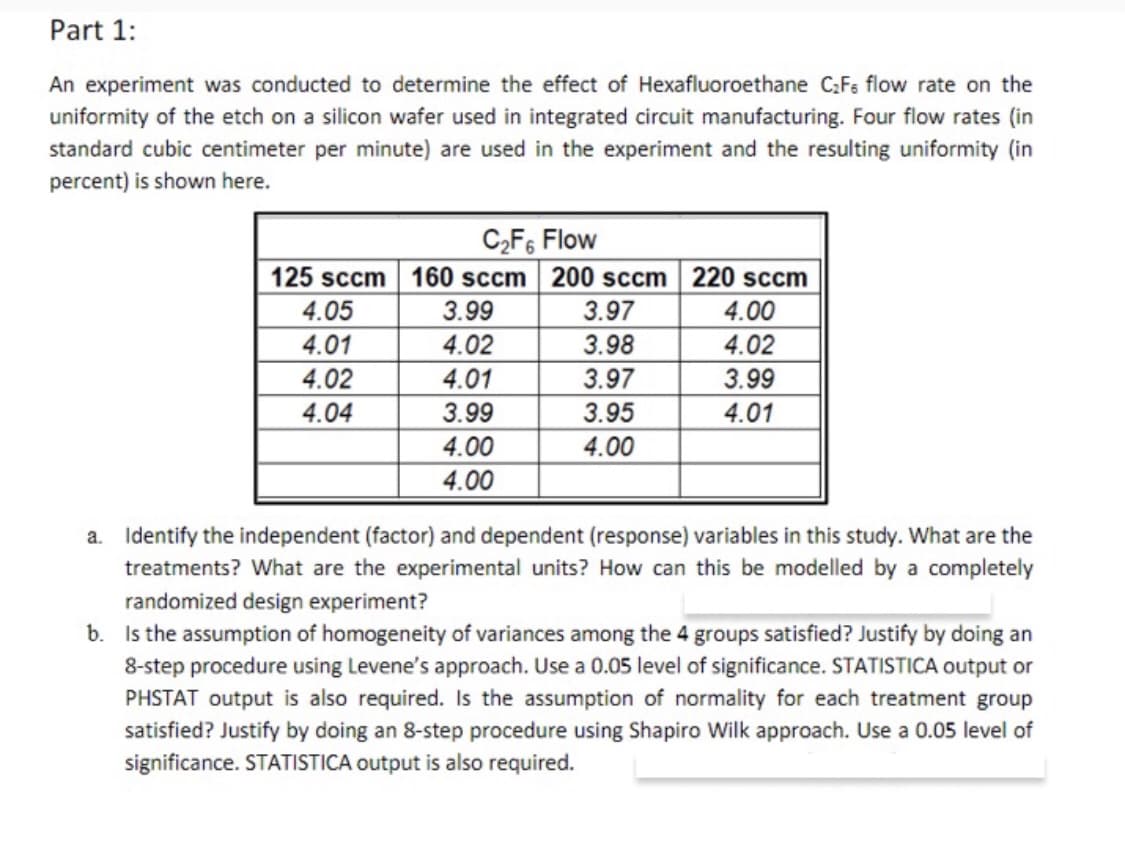Part 1: An experiment was conducted to determine the effect of Hexafluoroethane C:Fs flow rate on the uniformity of the etch on a silicon wafer used in integrated circuit manufacturing. Four flow rates (in standard cubic centimeter per minute) are used in the experiment and the resulting uniformity (in percent) is shown here. C2F6 Flow 125 sccm 160 sccm 200 sccm 220 sccm 3.99 4.05 3.97 4.00 4.01 4.02 3.98 4.02 4.02 4.01 3.99 3.97 3.99 4.04 3.95 4.01 4.00 4.00 4.00 a. Identify the independent (factor) and dependent (response) variables in this study. What are the treatments? What are the experimental units? How can this be modelled by a completely randomized design experiment? b. Is the assumption of homogeneity of variances among the 4 groups satisfied? Justify by doing an 8-step procedure using Levene's approach. Use a 0.05 level of significance. STATISTICA output or PHSTAT output is also required. Is the assumption of normality for each treatment group satisfied? Justify by doing an 8-step procedure using Shapiro Wilk approach. Use a 0.05 level of significance. STATISTICA output is also required.
Part 1: An experiment was conducted to determine the effect of Hexafluoroethane C:Fs flow rate on the uniformity of the etch on a silicon wafer used in integrated circuit manufacturing. Four flow rates (in standard cubic centimeter per minute) are used in the experiment and the resulting uniformity (in percent) is shown here. C2F6 Flow 125 sccm 160 sccm 200 sccm 220 sccm 3.99 4.05 3.97 4.00 4.01 4.02 3.98 4.02 4.02 4.01 3.99 3.97 3.99 4.04 3.95 4.01 4.00 4.00 4.00 a. Identify the independent (factor) and dependent (response) variables in this study. What are the treatments? What are the experimental units? How can this be modelled by a completely randomized design experiment? b. Is the assumption of homogeneity of variances among the 4 groups satisfied? Justify by doing an 8-step procedure using Levene's approach. Use a 0.05 level of significance. STATISTICA output or PHSTAT output is also required. Is the assumption of normality for each treatment group satisfied? Justify by doing an 8-step procedure using Shapiro Wilk approach. Use a 0.05 level of significance. STATISTICA output is also required.
MATLAB: An Introduction with Applications
6th Edition
ISBN:9781119256830
Author:Amos Gilat
Publisher:Amos Gilat
Chapter1: Starting With Matlab
Section: Chapter Questions
Problem 1P
Related questions
Question

Transcribed Image Text:Part 1:
An experiment was conducted to determine the effect of Hexafluoroethane C:Fs flow rate on the
uniformity of the etch on a silicon wafer used in integrated circuit manufacturing. Four flow rates (in
standard cubic centimeter per minute) are used in the experiment and the resulting uniformity (in
percent) is shown here.
C2F6 Flow
125 sccm
160 sccm 200 sccm 220 sccm
4.00
4.05
3.99
3.97
4.01
4.02
3.98
4.02
3.97
3.95
4.00
4.02
4.01
3.99
3.99
4.04
4.01
4.00
4.00
a. Identify the independent (factor) and dependent (response) variables in this study. What are the
treatments? What are the experimental units? How can this be modelled by a completely
randomized design experiment?
b. Is the assumption of homogeneity of variances among the 4 groups satisfied? Justify by doing an
8-step procedure using Levene's approach. Use a 0.05 level of significance. STATISTICA output or
PHSTAT output is also required. Is the assumption of normality for each treatment group
satisfied? Justify by doing an 8-step procedure using Shapiro Wilk approach. Use a 0.05 level of
significance. STATISTICA output is also required.

Transcribed Image Text:What are the appropriate null and alternative hypotheses for this study? What is the decision rule
using the critical number approach at the 0.05 level of significance? Make a sketch. Construct the
c.
ANOVA table. Show complete solutions for SST, SSTT, SSE, MSTT, MSE, F. Prove that there is
sufficient evidence that different treatments have a significant effect on uniformity at a = 5% both
by critical value and p-value approaches. STATISTICA output or PHSTAT output is also required.
d. Perform an appropriate post-hoc analysis to determine which treatment means differ. Complete
the Tukey-Kramer multiple pairwise comparisons by computing each absolute paired difference,
the HSD (Q-critical range), and copy the corresponding p-value from STATISTICA results. Or
submit the PHSTAT solution. Summarize your answer.
Expert Solution
This question has been solved!
Explore an expertly crafted, step-by-step solution for a thorough understanding of key concepts.
Step by step
Solved in 4 steps

Recommended textbooks for you

MATLAB: An Introduction with Applications
Statistics
ISBN:
9781119256830
Author:
Amos Gilat
Publisher:
John Wiley & Sons Inc

Probability and Statistics for Engineering and th…
Statistics
ISBN:
9781305251809
Author:
Jay L. Devore
Publisher:
Cengage Learning

Statistics for The Behavioral Sciences (MindTap C…
Statistics
ISBN:
9781305504912
Author:
Frederick J Gravetter, Larry B. Wallnau
Publisher:
Cengage Learning

MATLAB: An Introduction with Applications
Statistics
ISBN:
9781119256830
Author:
Amos Gilat
Publisher:
John Wiley & Sons Inc

Probability and Statistics for Engineering and th…
Statistics
ISBN:
9781305251809
Author:
Jay L. Devore
Publisher:
Cengage Learning

Statistics for The Behavioral Sciences (MindTap C…
Statistics
ISBN:
9781305504912
Author:
Frederick J Gravetter, Larry B. Wallnau
Publisher:
Cengage Learning

Elementary Statistics: Picturing the World (7th E…
Statistics
ISBN:
9780134683416
Author:
Ron Larson, Betsy Farber
Publisher:
PEARSON

The Basic Practice of Statistics
Statistics
ISBN:
9781319042578
Author:
David S. Moore, William I. Notz, Michael A. Fligner
Publisher:
W. H. Freeman

Introduction to the Practice of Statistics
Statistics
ISBN:
9781319013387
Author:
David S. Moore, George P. McCabe, Bruce A. Craig
Publisher:
W. H. Freeman